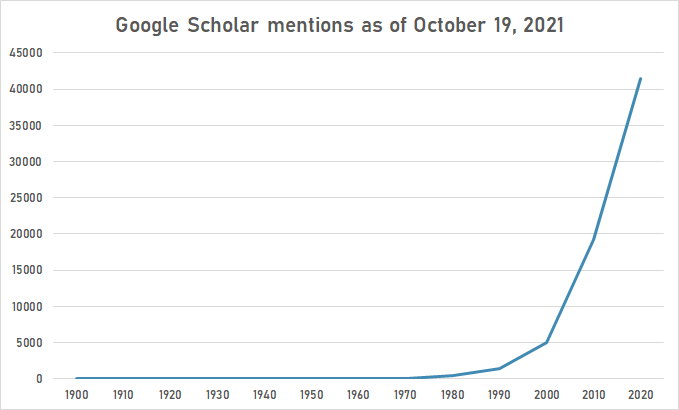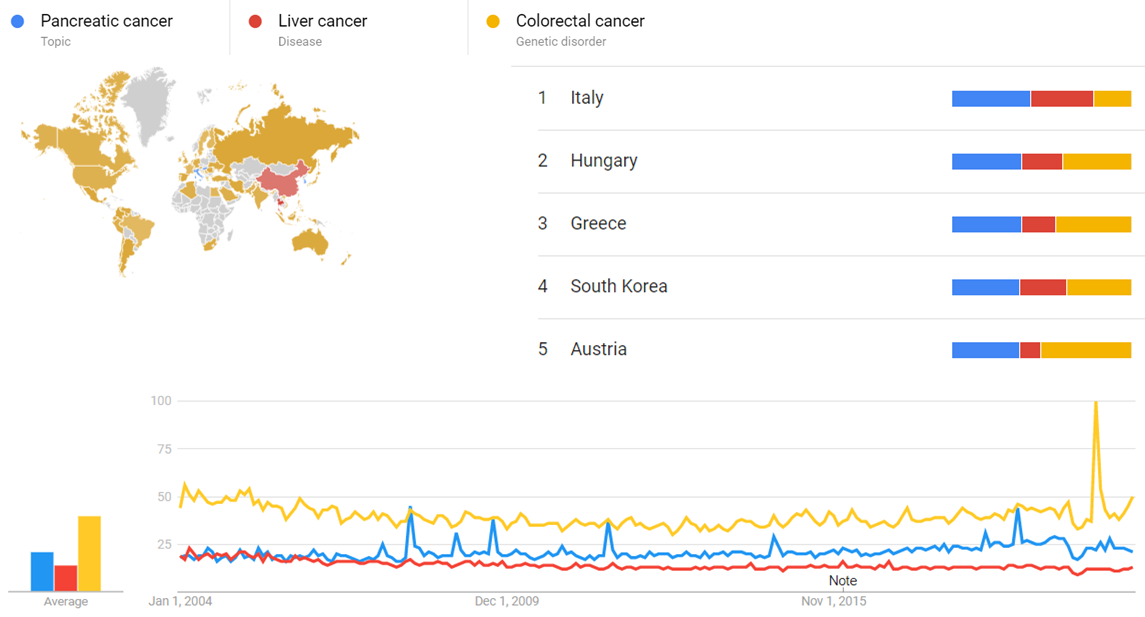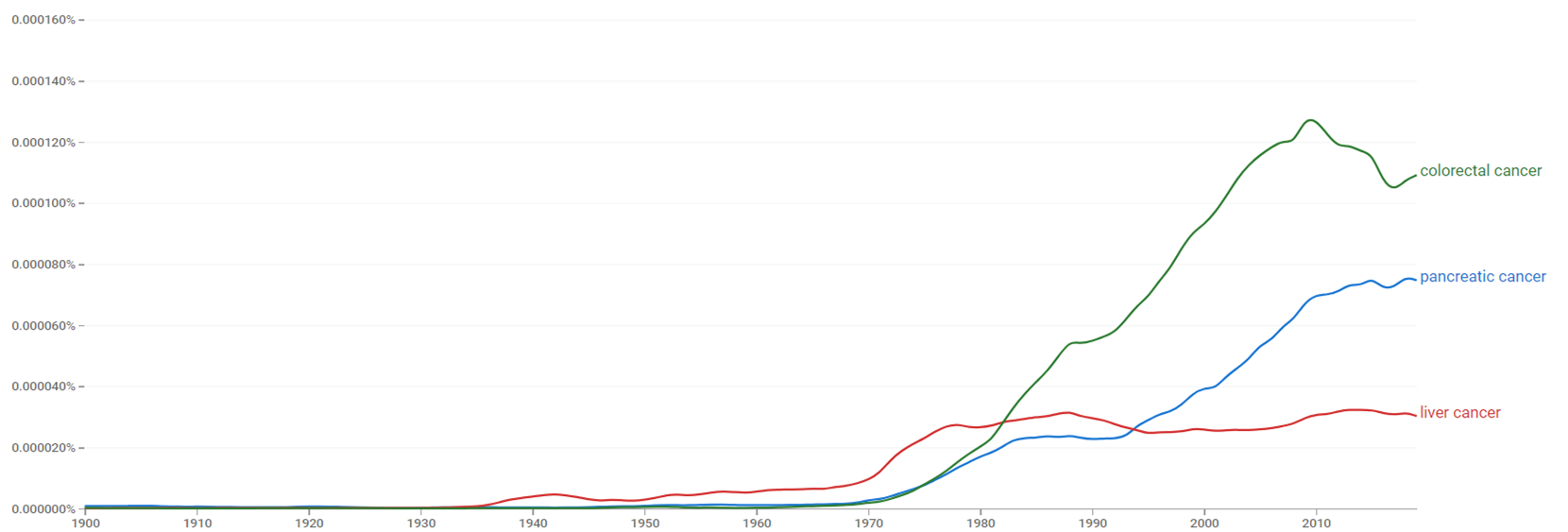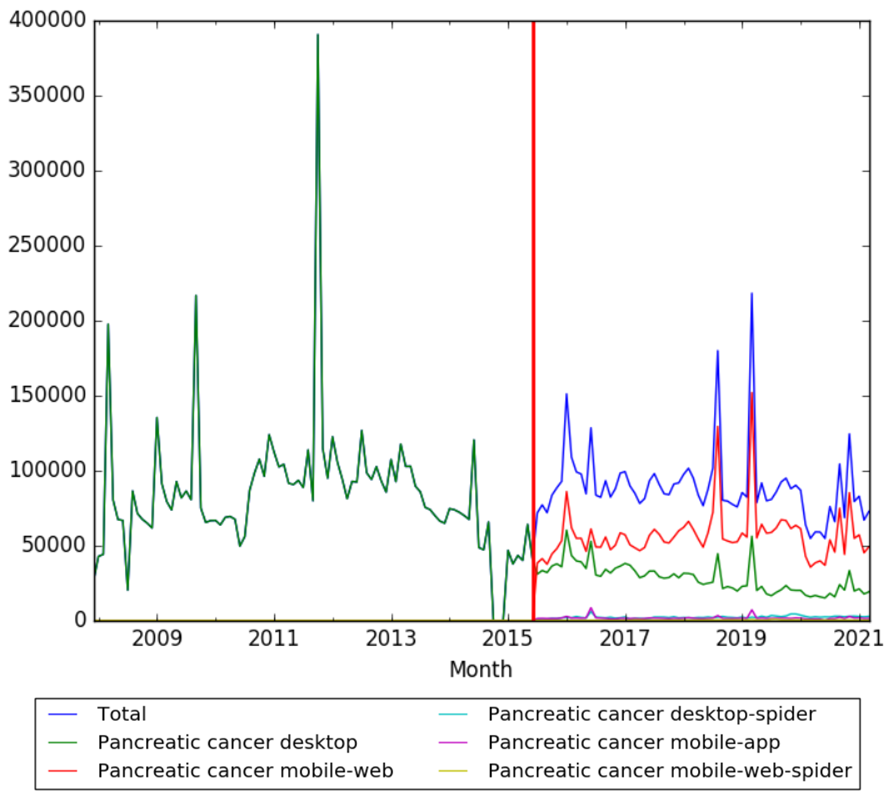Timeline of pancreatic cancer
This is a timeline of pancreatic cancer, describing especially major discoveries and advances in treatment of the disease.
Contents
Big picture
| Year/period | Key developments |
|---|---|
| 18th century | First description of pancreatic cancer in western medical literature. |
| 19th century | First manifestation of pancreatic cancer as a disease entity. First pancreaticoduodenectomy is attempted. |
| 20th century | Pancreaticoduodenectomy improves early in the century and becomes successful. Allen Whipple popularizes pancreaticoduodenectomy in the 1940s. In the 1970s tobacco use is found to cause pancreatic cancer. Chemotherapy drugs are released towards the end of the century in the United States. |
| 2000s | Researchers begin to use CT scan and endoscopic imaging to screen for pancreatic tumors. The pancreatic cancer genome is mapped.[1] |
| Recent years | Pancreatic cancer remains an invariably deadly disease without any improvements in patient outcome over the last two decades.[2] Pancreatic cancer is the twelfth most common cancer in the world, with 338,000 new cases diagnosed in 2012.[3] |
Full timeline
| Year/period | Type of event | Event | Location |
|---|---|---|---|
| 1761 | Development | Italian anatomist Giovanni Battista Morgagni is attributed with the first known description of pancreatic cancer in his publication De Sedibus Et Causis Morborum Per Anatomen Indagatis Libri Quinque.[4] | |
| 1858 | Development | American physician Jacob Mendez Da Costa describes the first microscopic diagnosis of adenocarcinoma, manifesting pancreatic cancer as a true disease entity.[4] | |
| 1898 | Development | Italian surgeon Alessandro Codivilla performs the first reported attempt at a pancreaticoduodenectomy for a tumor involving the head of the pancreas (the patient did not survive the postoperative period).[4] | |
| 1906 | Development | Scottish embryologist John Beard proposes that pancreatic proteolytic digestive enzymes represent the body's main defense against cancer, and that enzyme therapy would be useful as a treatment for all types of cancer.[5] | |
| 1909 | Development | German surgeon Walter Kausch first describes the pancreaticoduodenectomy procedure.[6] | |
| 1914 | Achievement | German surgeon Georg Hirschel performs the first successful pancreaticoduodenectomy in one stage.[4] | |
| 1937 | Achievement | American physician Alexander Brunschwig performs the first successful pancreaticoduodenectomy in two stages for pancreatic cancer.[7] | |
| 1940 | Development | American surgeon Allen Whipple performs a successful one-stage pancreaticoduodenectomy, being the first to popularize the procedure (today also called Whipple procedure). His major surgical operation involves the removal of the head of the pancreas, the duodenum, the proximal jejunum, gallbladder, and often the distal stomach. This operation is performed to treat cancerous tumours of the head of the pancreas, malignant tumors involving the common bile duct, duodenal papilla or ampulla of Vater, or duodenum near the pancreas, some precancerous lesions, some cases of pancreatitis with or without a definitive cause, and rarely, severe trauma.[8] | United States |
| 1942 | Achievement | First successful total pancreatectomy is performed at Mayo Clinic, for an insulinoma.[9] | Rochester, Minnesota, US |
| 1944 | Discovery | First report of tuberculosis mimicking pancreatic cancer.[10] | |
| 1947 | Discovery | First recognition of a causative relationship between the subcutaneous adiponecrosis and pancreatic cancer.[11] | |
| 1951 | Development | First performance of resection and reconstruction of the superior mesenteric vein for pancreatic cancer at University of Minnesota.[12] | Minnesota, US |
| 1955 | Development | Researchers first describe the clinical features of a gastrinoma (a tumor in the pancreas or duodenum).[13] | |
| 1958 | Development | Researchers first describe the persistent watery diarrhea and hypokalemia associated with a pancreatic islet-cell tumor.[13] | |
| 1963 | Development | The first case of pancreatic cancer with skeletal metastases is described.[14] | Russia |
| 1967 | Discovery | Study shows that more than half of patients with pancreatic cancer have psychological symptoms occurring as early as 43 months before physical symptoms.[15] | |
| 1979 | Discovery | Researchers discover biomarker CA 19-9 (commonly for diagnosis and management of patients with pancreatic cancer).[16] | |
| 1981 | Treatment | Researchers discover that adding fluorouracil to standard radiation boosts one year survival from 10 percent to 40 percent for patients with locally advanced inoperable pancreatic cancer.[1] | |
| 1981 | Discovery | Study at University of Maryland Medical Center links environmental exposure to pancreatic cancer. Researchers discover that male victims are more often employed in the dry-cleaning business or in occupations involving close exposure to gasoline. They also find that women at risk of PC are more likely to smoke cigarettes, have uterine tumors and have had ovaries removed or have miscarriages.[17] | Baltimore, Maryland, US |
| 1985 | Treatment | Chemotherapy plus radiation are found to be effective as adjuvant therapy for patients with earlier stage of pancreatic cancer.[1] | |
| 1992 | Development | Endoscopic ultrasound guided fine needle aspiration (EUS-FNA) of a pancreatic mass is first described. Today it is the preferred method to sample pancreatic mass lesions.[18] | |
| 1993 | Development | Researchers show that a vaccine composed of tumor cells irradiated and genetically modified to produce immune system growth factor GM-CSF could induce potent, specific, and long-lasting anti-tumor immunity in mice. This work leads to the therapeutic cancer vaccine GVAX.[19] | United States |
| 1994 | Discovery | Study finds that longtime cigarette smokers double their risk of pancreatic cancer.[20] | United States |
| 1996 | Treatment | Gemcitabine is approved for pancreatic cancer that has spread to nearby organs or to distant parts of the body, after clinical trial demonstrates that it modestly extends survival compared to fluorouracil, the previous standard of care.[1] | |
| 1998 | Development | First description of pancreatic stellate cells (star-shaped cells that play an essential role in pancreatic fibrosis in chronic pancreatitis and pancreatic cancer).[2] | |
| 1999 | Organization | The Lustgarten Foundation for Pancreatic Cancer Research is established as a non-profit organization with the mission of advancing scientific and medical research related to the diagnosis, treatment, cure and prevention of pancreatic cancer.[21] | Bethpage, New York, US |
| 2004 | Treatment | The European Study Group for Pancreatic Cancer (ESPAC) finds that adjuvant use (after surgery) of fluorouracil more than doubles 5 year survival for patients with early pancreatic cancer.[1] | |
| 2005 | Treatment | United States FDA approves targeted drug erlotinib after trial finds that adding it to standard gemcitabine chemotherapy extends the lives of patients with inoperable pancreatic cancer, compared to gemcitabine alone.[1] | United States |
| 2007 | Development | First description of pancreatic cancer stem cells. Since then, a number of cancer cells with distinct functional features (including self-renewal and exclusive in vivo tumorigenicity) emerges.[22] | |
| 2007–2008 | Treatment | Two important studies demonstrate that adjuvant (post-surgery) treatment with gemcitabine, further extends survival for patients with early pancreatic cancer.[1] | |
| 2008 | Study | The pancreatic cancer genome is mapped. 63 genetic abnormalities are identified, along 12 key "pathways" that are present in the vast majority of pancreatic tumors.[1] | |
| 2009 | Organization | The Pancreatic Cancer Action is established as a non-profit organization whose mission is to raise awareness of pancreatic cancer.[23] | Hampshire UK |
| 2010 | Treatment | Major trial shows that initial treatment with FOLFIRINOX chemotherapy extends survival by nearly five months in patients with advanced pancreatic cancer, compared with standard gemcitabine treatment.[1] | |
| 2013 | Treatment | Study shows that combination of two chemotherapy drugs protein-bound paclitaxel and gemcitabine is more effective than standard single drug therapy for people with metastatic pancreatic cancer.[1] | |
| 2014 | United States FDA designates GVAX given with another immunotherapy, CRS-207, as a “Breakthrough Therapy” for pancreatic cancer.[19] | United States |
Numerical and visual data
Google Scholar
The following table summarizes per-year mentions on Google Scholar as of October 19, 2021.
| Year | "pancreatic cancer" |
|---|---|
| 1900 | 4 |
| 1910 | 4 |
| 1920 | 2 |
| 1930 | 6 |
| 1940 | 3 |
| 1950 | 9 |
| 1960 | 29 |
| 1970 | 64 |
| 1980 | 459 |
| 1990 | 1,480 |
| 2000 | 5,000 |
| 2010 | 19,300 |
| 2020 | 41,500 |
Google Trends
The comparative chart below shows Google Trends data for Pancreatic cancer (Topic), liver cancer (Disease), and colorectal cancer (Genetic disorder), from January 2004 to March 2021, when the screenshot was taken. Interest is also ranked by country and displayed on world map.[24]
Google Ngram Viewer
The comparative chart below shows Google Ngram Viewer data for pancreatic cancer, liver cancer, and colorectal cancer, from 1900 to 2019.[25]
Wikipedia Views
The chart below shows pageviews of the English Wikipedia article Ppancreatic cancer, on desktop from December 2007, and on mobile-web, desktop-spider, mobile-web-spider and mobile app, from July 2015; to February 2021. A data gap on desktop observed from October 2014 to December 2014 is the result of Wikipedia Views failure to retrieve data.[26]
See also
- Timeline of colorectal cancer
- Timeline of kidney cancer
- Timeline of lung cancer
- Timeline of brain cancer
- Timeline of liver cancer
- Timeline of bladder cancer
References
- ↑ 1.0 1.1 1.2 1.3 1.4 1.5 1.6 1.7 1.8 1.9 "Pancreatic Cancer".
- ↑ 2.0 2.1 Kolodecik, T; Shugrue, C; Ashat, M; Thrower, EC (2013). "Risk factors for pancreatic cancer: underlying mechanisms and potential targets". Front Physiol. 4: 415. PMC 3893685
 . PMID 24474939. doi:10.3389/fphys.2013.00415.
. PMID 24474939. doi:10.3389/fphys.2013.00415.
- ↑ "Pancreatic cancer statistics". Retrieved 18 September 2016.
- ↑ 4.0 4.1 4.2 4.3 "Pancreatic cancer: yesterday, today and tomorrow". Retrieved 13 September 2016.
- ↑ "Enzyme Therapy and Cancer". Retrieved 13 September 2016.
- ↑ "Current Concepts in Pancreatic Cancer". doi:10.5772/60451.
- ↑ Evans, Douglas B. Pancreatic Cancer.
- ↑ Griffin, JF; Poruk, KE; Wolfgang, CL (2015). "Pancreatic cancer surgery: past, present, and future". Chin. J. Cancer Res. 27: 332–48. PMC 4560737
 . PMID 26361403. doi:10.3978/j.issn.1000-9604.2015.06.07.
. PMID 26361403. doi:10.3978/j.issn.1000-9604.2015.06.07.
- ↑ M. Lowy, Andrew; Leach, Steven D.; Philip, Philip. Pancreatic Cancer.
- ↑ "Pancreatic tuberculosis with splenic tuberculosis mimicking advanced pancreatic cancer with splenic metastasizes: a case report". Retrieved 14 September 2016.
- ↑ "Lobular panniculitis: A manifestation of pancreatic tumor with fatal outcome" (PDF). Retrieved 14 September 2016.
- ↑ Al-Refaie, Waddah B. Vascular Resection for Pancreatic Cancer.
- ↑ 13.0 13.1 Pancreatic Cancer, Cystic Neoplasms and Endocrine Tumors.
- ↑ Borad, MJ; Saadati, H; Lakshmipathy, A; Campbell, E; Hopper, P; Jameson, G; Von Hoff, DD; Saif, MW (2009). "Skeletal Metastases in Pancreatic Cancer: A Retrospective Study and Review of the Literature". Yale J Biol Med. 82: 1–6. PMC 2660584
 . PMID 19325940.
. PMID 19325940.
- ↑ "Depression and Pancreatic Cancer: A Poorly Understood Link".
- ↑ Poruk, KE; Gay, DZ; Brown, K; Mulvihill, JD; Boucher, KM; Scaife, CL; Firpo, MA; Mulvihill, SJ (2013). "The Clinical Utility of CA 19-9 in Pancreatic Adenocarcinoma: Diagnostic and Prognostic Updates". Curr. Mol. Med. 13: 340–51. PMC 4419808
 . PMID 23331006. doi:10.2174/156652413805076876.
. PMID 23331006. doi:10.2174/156652413805076876.
- ↑ "Pancreatic cancer tied to environmental causes". The Day. Retrieved 14 September 2016.
- ↑ Luz, LP; Al-Haddad, MA; Sey, MS; DeWitt, JM (2014). "Applications of endoscopic ultrasound in pancreatic cancer". World J. Gastroenterol. 20: 7808–18. PMC 4069310
 . PMID 24976719. doi:10.3748/wjg.v20.i24.7808.
. PMID 24976719. doi:10.3748/wjg.v20.i24.7808.
- ↑ 19.0 19.1 "Review of Major Discoveries and Accomplishments". Retrieved 14 September 2016.
- ↑ "Smoking can double risk of pancreatic cancer". Ludington Daily News.
- ↑ "The Lustgarten Foundation for Pancreatic Cancer Research". Retrieved 14 September 2016.
- ↑ "Concise Review: Stem Cells in Pancreatic Cancer: From Concept to Translation". STEM CELLS. 33: 2893–2902. doi:10.1002/stem.2114.
- ↑ "Pancreatic Cancer Action". Retrieved 14 September 2016.
- ↑ "pancreatic cancer, liver cancer, colorectal cancer". Google Trends. Retrieved 3 April 2021.
- ↑ "pancreatic cancer, liver cancer, colorectal cancer". books.google.com. Retrieved 3 April 2021.
- ↑ "Pancreatic cancer". wikipediaviews.org. Retrieved 4 April 2021.
Category:Pancreatic cancer Category:Health-related timelines



